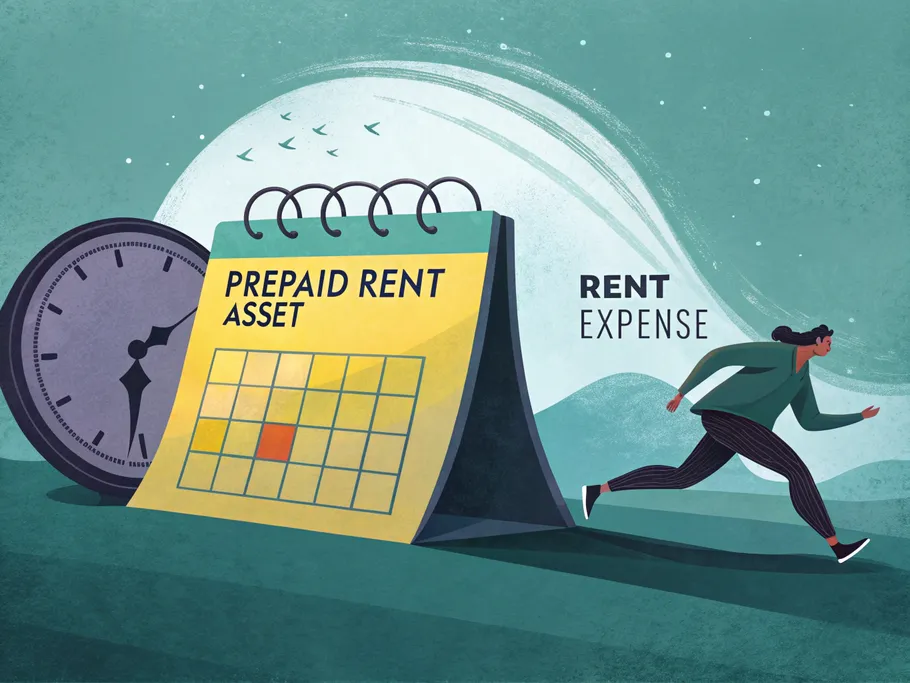Prepaid rent is exactly what it sounds like: you’re paying for a lease before the rental period actually begins. Think of it as buying a concert ticket months in advance. You own the right to go to the show, but you haven’t experienced it yet.
Businesses might do this to snag a discount or just to keep the landlord happy. While it can cover any period, paying one month in advance is the most common play.
So, what is prepaid rent in accounting? It’s classified as a prepaid expense. This means it’s a balance sheet account that represents a future benefit you’ve paid for but haven’t used up yet. It’s a promise of a place to work, not the work itself.
Prepaid Rent is a Current Asset, Not an Expense (At First)
Here’s the plot twist: when you prepay rent, you’re not recording an expense. You’re buying an asset.
Why? Because that payment gives you a future economic benefit – the right to use the property. It’s a prepaid rent current asset because you’ll “consume” that benefit within a year.
A wanderer carried a pouch of seeds, a silent promise against the lean years. These were not mere grains, but stored potential, a future harvest held in hand. With each season’s turning, they were sown, transforming from the wealth of tomorrow into the sustenance of today.
That’s your prepaid rent. It’s a seed of future value. As each month passes, a portion of that asset gets “used up” and becomes an expense on your income statement. This is the key difference between prepaid rent and rent expense.
Permanent vs. Temporary Accounts
To really get this, you need to understand the two main types of accounts. Think of it like this: some accounts have the decency to reset to zero every year, while others just… don’t.

Permanent Accounts Explained
These are your financial tattoos. They stick around year after year, carrying their balances forward. They live on the balance sheet and include:
- Asset accounts: Cash, Accounts Receivable, and our star, Prepaid Rent.
- Liability accounts: Accounts Payable, Loans Payable, and other debts you owe.
- Equity accounts: Capital stock, retained earnings, and the value belonging to the owners.
Temporary Accounts Explained
These accounts get a fresh start every year. They track the drama for a single accounting period, and then their balances are wiped clean and moved into retained earnings. They include:
- Revenue accounts: Sales, service fees, etc.
- Expense accounts: Cost of goods sold, rent expense, supplies.
- Gain and loss accounts: For one-off events like selling an old piece of equipment.
So, Is Prepaid Rent a Permanent or Temporary Account?
Because it’s an asset on the balance sheet, prepaid rent is a permanent account. Its balance carries over.
However, when you “use up” a month of rent, you record Rent Expense, which is a temporary account. The value moves from the permanent asset account to the temporary expense account, which gets zeroed out at the end of the year.
Accounting Treatment for Prepaid Rent
Under accrual accounting and GAAP’s matching principle, you record expenses when they are incurred, not when you pay them. In essence, we’re just delaying the bad news and calling it a ‘matching principle’.
Since the rent isn’t technically incurred until you occupy the space for that month, the initial payment has to be recorded as an asset first.
The Initial Journal Entry: It’s an Asset, Baby!
When you cut the check, you debit the Prepaid Rent account (increasing your assets) and credit your Cash account (decreasing your cash). It’s a simple swap.
| Date | Account | Debit | Credit |
|---|---|---|---|
| DD/MM/YYYY | Prepaid Rent | $$ | |
| Cash | $$ |
The Adjusting Journal Entry: Turning Assets into Expenses
As time passes and you actually use the space, you need to make monthly adjusting entries to recognize the expense. This is how to calculate prepaid rent adjusting entries: you take the total prepayment and divide it by the number of months it covers.
Each month, you debit Rent Expense and credit Prepaid Rent.
| Date | Account | Debit | Credit |
|---|---|---|---|
| DD/MM/YYYY | Rent Expense | $$ | |
| Prepaid Rent | $$ |
This entry shows you’ve “consumed” part of your asset and correctly matches the expense to the period you incurred it.

Examples of Prepaid Rent Journal Entries
Let’s put this into practice. Theory is cute, but examples pay the bills.
Example 1: Six-Month Prepayment
Company ABC pays a hefty $24,000 for six months of office space upfront.
- Initial Journal Entry:
| Account | Debit | Credit |
|---|---|---|
| Prepaid Rent | $24,000 | |
| Cash | $24,000 |
This parks the full amount in an asset account.
- Monthly Adjusting Entry: Each month, the company has to recognize one month’s worth of rent expense ($24,000 / 6 months = $4,000).
| Account | Debit | Credit |
|---|---|---|
| Rent Expense | $4,000 | |
| Prepaid Rent | $4,000 |
This moves $4,000 from the balance sheet (asset) to the income statement (expense).
Example 2: Six-Month Prepayment with Tables
A company pays $120,000 for six months of rent.
- Initial Entry:
| Account | Debit | Credit |
|---|---|---|
| Prepaid Rent | $120,000 | |
| Cash | $120,000 |
- Monthly Adjusting Entry: The monthly rent expense is $20,000 ($120,000 / 6).
| Account | Debit | Credit |
|---|---|---|
| Rent Expense | $20,000 | |
| Prepaid Rent | $20,000 |
Quick note: If you pay $600,000 for six months of rent, you’d initially record $600,000 as prepaid rent. After four months, $400,000 would be expensed, and the remaining $200,000 would still be “sitting” on your balance sheet as a prepaid rent asset.
Takeaways
Let’s clear this up once and for all.
Prepaid rent is initially increased by debit. When you make the payment, you debit the Prepaid Rent asset account to increase its balance. This shows you’ve acquired the right to use the property.

As you consume the rent, you credit the Prepaid Rent account in your adjusting entries, which decreases the asset’s value. At the same time, you debit the Rent Expense account, finally recognizing the cost for that period.
So, to recap: it starts as a debit in a permanent asset account, and then it’s slowly credited away as the expense is recognized in a temporary expense account. Getting this right is key to keeping your financial reports sharp and accurate.
